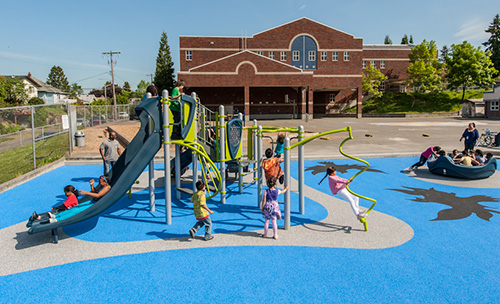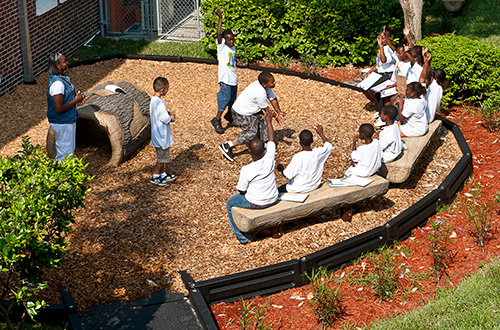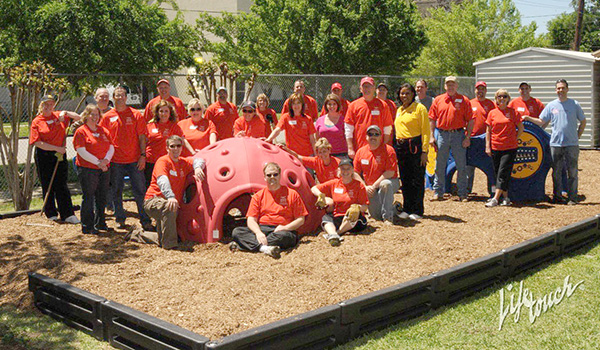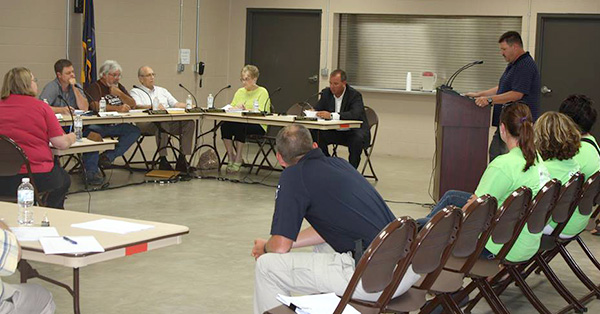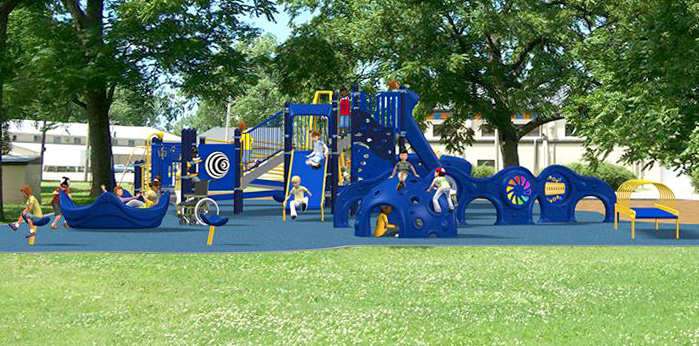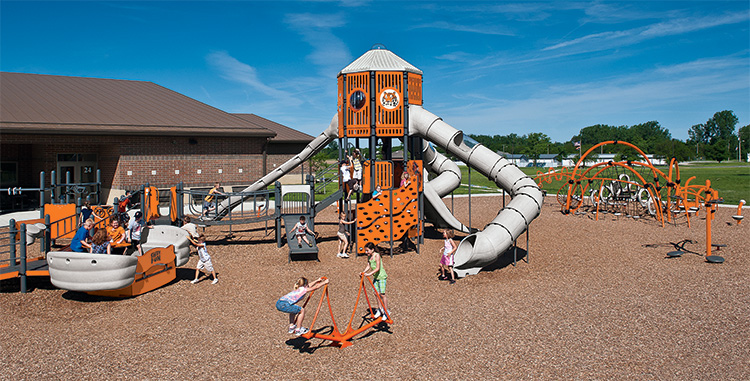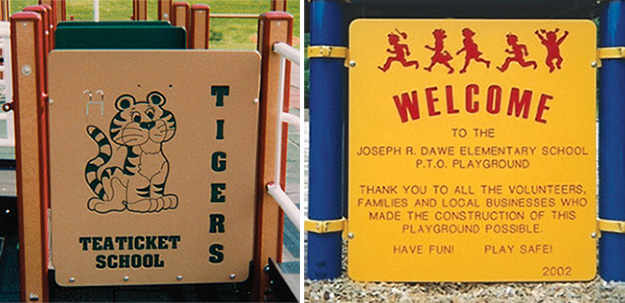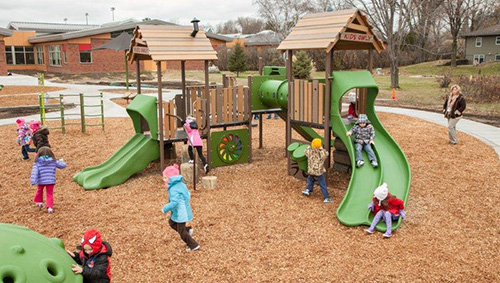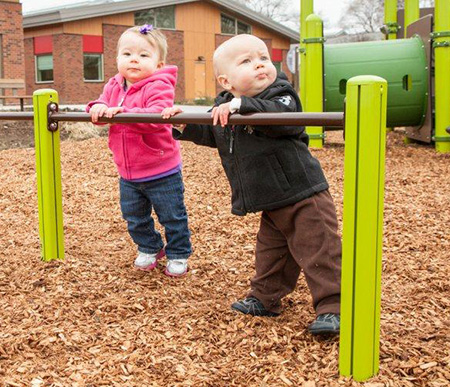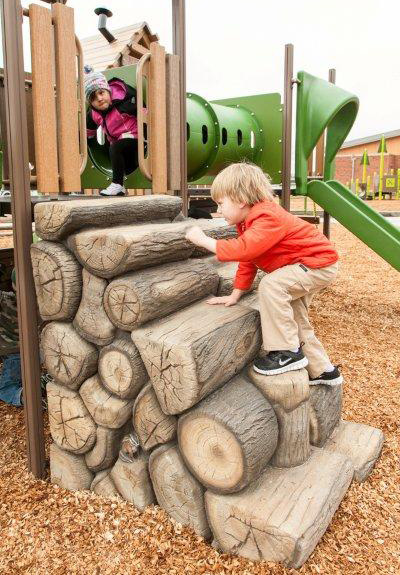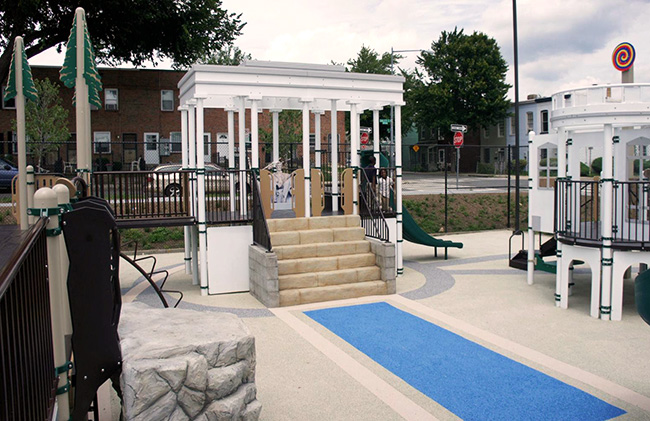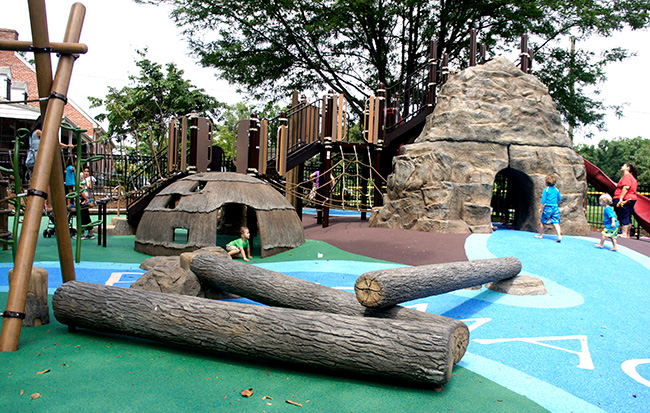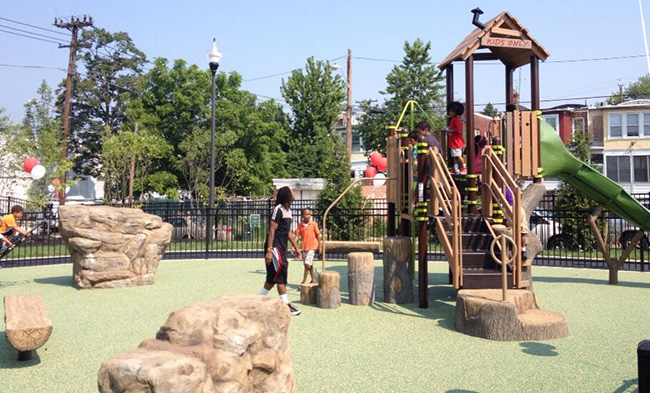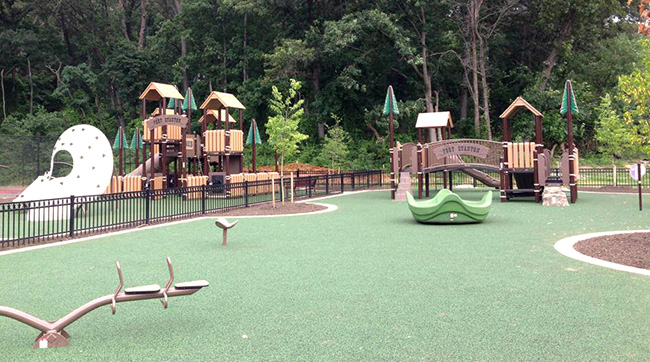The second annual Green Apple Day of Service, a day sponsored by the USGBC’s Center for Green Schools, took place on Friday, Sept. 27. We celebrated a day early by partnering with the MN Green Schools Coalition to help Delano Elementary School (DES) in Delano, Minn., improve their existing composting program. Throughout the week, DES’s media teacher read Compost Stew to each class and they completed a fun, classroom activity. Then on Friday, Sept. 27, we helped students compost their lunch waste, and handed out apples and goodie bags to each student and staff member. By participating in this program, the MN Green Schools Coalition awarded DES dollars to purchase new library books with an environmental theme. Check out the video of the event below, and go here to learn more about our community outreach.
Bringing play to schools around the nation
We’re honored to partner with the National Association of Elementary School Principals (NAESP) on their Community Service Day. For the past four years, we’ve worked side-by-side with principals from around the nation to build and beautify school playgrounds in conjunction with the organization’s annual conference.
In July, we worked with NAESP members to install an inclusive playground at John Ruhrah Elementary/Middle School in Baltimore, Md. Principal Mary C. Donnelly said that she thinks the new playground will dramatically increase the use of outdoor grounds for both school instruction as well as recreation. As we completed the playground project with NAESP this year, we thought it would be fun to look back at the other schools we’ve helped over the years.
Principals congregated at Seattle’s Hawthorne Elementary School in March 2012 to build an inclusive playground. In just a few hours, the inclusive PlayBooster® playstructure was installed, allowing the principals to network with each other and interact with Hawthorne Elementary students.
In April 2011, we created a nature-inspired outdoor learning environment for Booker T. Washington Elementary School in Tampa, Fla. Now more than two years later, Principal Toynita Martinez says the outdoor classroom concept is being embraced. “All of our teachers are taking advantage of the outdoor classroom,” said Martinez. “A lot of math and science classes take place outside. Plus, reading groups disperse in the space to finish a reading assignment and then come together to discuss.”
Our first time participating in the NAESP Community Service Day was in 2010. We designed a sensory-rich play space complete with the Sensory Play Center® and Cozy Dome® for students at MacGregor Music and Science Academy in Houston, Texas. “We’re really proud and still excited about the gift that NAESP and Landscape Structures provided,” said Principal Patricia Allen of the playground.
Learn more about our partnership with NAESP, and our joint commitment to enhancing the lives of children and the communities in which they live.
Meet the professional: Dr. Lucy Jane Miller
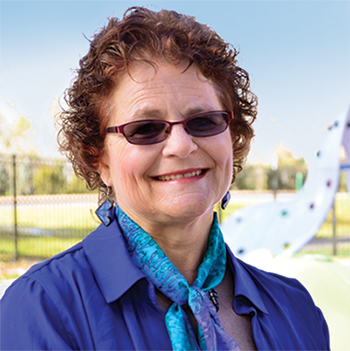 We are so honored to work with clients around the world, and we’re constantly learning about their fun and unique projects, obstacles they’ve faced and the innovative solutions they’ve created to overcome challenges. That’s why we’ve created this new feature that spotlights professionals. This week, meet Dr. Lucy Jane Miller, founder of the Sensory Processing Disorder (SPD) Foundation and the STAR Center. Below, you’ll learn how she came to begin her career, and what lead her to start the SPD Foundation.
We are so honored to work with clients around the world, and we’re constantly learning about their fun and unique projects, obstacles they’ve faced and the innovative solutions they’ve created to overcome challenges. That’s why we’ve created this new feature that spotlights professionals. This week, meet Dr. Lucy Jane Miller, founder of the Sensory Processing Disorder (SPD) Foundation and the STAR Center. Below, you’ll learn how she came to begin her career, and what lead her to start the SPD Foundation.
When I was 16-years-old, I stopped seeing things the way other people do. Literally.
Without contact lenses in my eyes, objects were growing blurrier and blurrier. With contacts in, I could see but my eyes ached until, after several hours, I could hardly bear the pain. Only a few months earlier, I’d been thinking about where to go to college, what to do for the summer and all the other things typical 16-year-old girls think about. Then this one big sensory piece started to fail—my sense of sight—and my whole world shifted. My parents took me to a local ophthalmologist but he brushed aside my complaints. “There’s nothing the matter with her eyes,” he told us. “It’s all in her head.”
I was in college before we solved the mystery of my fading vision. By then, wearing contact lenses for more than a few minutes had become agony and even enormous shapes were fuzzy without them. It was my alarmed freshman roommate who insisted I see a doctor at the school clinic, triggering a series of referrals that finally brought answers and help. I was diagnosed with advanced keratoconus, a disease that distorts the corneas and—without treatment—eventually, leads to blindness.
The diagnosis was grave but it also came as a relief. My vision problems weren’t all in my head after all! The symptoms were real and they had a name. I finally knew what I was fighting and could make a plan for fighting it.
The year was 1971 and the cure for the disease was corneal transplants in both eyes, a procedure only two doctors in the U.S. were qualified to perform. I went on a waiting list for donor corneas, doubling up on classes so I could finish college before my surgery, learning Braille and practicing with a white cane, just in case the cure didn’t work and I lost what was left of my eyesight. A few weeks before graduation, I reached the top of the list for my first transplant. During the two-hour surgery, the old bad right cornea was removed and a new donated cornea was stitched to my eyeball with 16 sutures that would jab my eye and eyelid like teensy relentless needles for the three months after surgery when both my eyes had to be patched.
The operation was a total success, but I felt lost in my carefully maintained darkness. The endless stream of doctors, fellows, residents and medical students who gazed admiringly at my eye murmured, “beautiful, beautiful,” but I didn’t feel beautiful at all. I couldn’t see. I made a mess when I tried to eat. I couldn’t perform basic personal hygiene tasks and, after a lifetime seeing people when I talked, it didn’t feel like communication when I talked in the dark. What’s more, the admiring medical people who visited seemed to care only about my beautiful new eye. I felt reduced to a single sensory organ—an eyeball.
Then a new person entered my life. She was a young occupational therapy student doing her internship and she had been assigned to teach me how to feed, dress and take care of myself. She was about my age and showed no interest in my eyeball at all. Instead, she talked to me, Lucy Jane Miller, and listened to what I said. She always wanted to know how I—not my eye—was doing and she told me little things about her life so we had a real relationship even though I couldn’t see her. I silently called her “Angel” and imagined her with long blonde hair, blue eyes, a perfect Olympian body, and a halo, of course. I learned to identify her footsteps and detect her scent so I could say, “Hi, Angel!” just as she came into my room.
Then came the day when Angel chanced into the room when my patches were being changed and I finally glimpsed my rescuer with my eyes as well as with my other senses. The sight astonished me. Angel was a polio survivor. Half her face and body had been paralyzed and left sagging by the disease. In my darkness, Angel was beautiful because I could only “see” the beauty that was inside.
In the fog of recuperation, my future came into focus. While still in my eye patches, I applied to occupational therapy school. Two days after the last stitches were removed following my second transplant, I started graduate school.
One of the first books I read with my new good eyes was the work of a pioneering occupational therapist and neuroscientist named A. Jean Ayres. In Sensory Integration and Learning Disabilities, Dr. Ayres wrote in detail about the behavioral, social and emotional issues that arise when a child’s sensory foundation is not firmly established early in life. She stressed the importance of early diagnosis of sensory disorders and described in detail how occupational therapy (OT) could and was helping children. Fresh as I was from my own darkness, Dr. Ayres’ words resonated instantly.
Demoralized and disabled by the long-term repercussions of a doctor’s proclamation that my symptoms were all in my head, I knew how critical accurate and early diagnosis was. Barely out of my teens, I had known the humiliation of being unable to perform normal, everyday routines like other people my age. Grateful for Angel’s care, I was a firm believer in how dramatically OT could address sensory issues and improve a person’s life. Before first semester ended, I decided to spend my life promoting the understanding, accurate diagnosis and effective treatment of the sensory-based disorders that Dr. Ayres described.
From Sensational Kids: Hope and Help for Children with Sensory Processing Disorder (SPD)
Learn more about Dr. Miller and the research, education and treatment she provides to help individuals struggling with SPD. Then read about our partnership with the SPD Foundation and the STAR Center, including its sensory playground.

Guest Blog: Securing funds for our inclusive playground
In June, we awarded the Iola Kiwanis club in Iola, Kan., $25,000 in playground equipment as part of the Make a Difference Through Play contest. Since winning, they’ve been busy with plans, and we’re happy to have an update to share from Michael Ford, member of the Iola Kiwanis club and community resource officer for the Iola Police Department.
After we were notified that we were the grand prize winners of the Make a Difference Through Play contest, our Kiwanis club met with the city council during open council to tell them about the $25,000 award from Landscape Structures. We took advantage of our time in front of them and also asked if they would consider pledging a matching donation to the inclusive playground. They agreed, which already put us at nearly 30 percent of our fundraising goal.
The award and the matching donation had our Kiwanis club energized, and we took that energy to meet with other local businesses to secure funds. The Iola Wal-Mart and a local bank each pledged $5,000, our Kiwanis club has pledged at least $2,500, and we have many more businesses pledging support with donations of anywhere from $500 to $1,500.
We’re working on a couple of grant applications—one through the Kansas Health Foundation and another with KaBOOM!. We also have fundraisers scheduled—a pancake breakfast, concessions at Farm City Days in Iola—with businesses pledging matching funds. Additionally, local construction companies have offered to donate materials when it comes time for the playground installation.
Iola is a city of 5,600 people. When you’re in a town this size, the community members know what’s happening in town. So while we have reached out to many businesses for donations, many have also approached us. We are trying to broaden our reach with a county-wide mailer to tell businesses and individuals that a fund has been set up through the Allen County Foundation so that they can easily make tax-deductible donations.
Another aspect that was unexpected in this process was helping educate the community about planning, funding and installing a playground. Lots of the community members figured that we’d get the $25,000 from Landscape Structures and that would be it. But our vision is for a truly inclusive playground, and we realized quickly that we weren’t willing to cut back on the amount of playground equipment we wanted, and set our budget to meet that dream.
Stay tuned for another update from Michael next month when he’ll discuss getting community support.
Show your school spirit… on the playground
Personalization adds a unique element to playgrounds, and it also lets you show your school spirit! Versailles Elementary School in Versailles, Ohio, went all out to show their support for the Tigers. By incorporating their school colors—orange and gray—and a couple of personalized panels showing their school mascot, there is no doubt to anyone that visits the playground that it is the home of the Tigers.
Not only can we help you create an entirely personalized playground like Versailles Elementary, but we can add any level of personalization to best meet your needs. From a personalized welcome sign to playground panels with your school name, motto or mascot, or a customized freestanding play component, we’ll help make your school playground design your own.
Reconnecting kids with nature
In the past few years, we’ve noticed an increase in childcare facilities focused on nature-inspired activities and nature-themed playground equipment. And the Early Childhood Family Center (ECFC) in Stillwater, Minn., is just one example of a childcare facility providing opportunities for kids to reconnect with nature.
“Our ECFC chose a nature-inspired playground, which accents the surrounding landscape,” explained Betty Soine, early childhood supervisor. “Also, research supports the value of using natural environments to encourage children’s overall growth and development. Our parent education program encourages parents to get outside with children during all seasons to experience the variety of outdoor environments, breathe the fresh air and explore the wonders of nature through the eyes of their child. An outdoor play environment that mimics nature supports a health and wellness focus for all our families and staff.”
The Early Childhood Family Center added a nature-inspired playground designed for kids ages 6 to 23 months. The Infant Single Poly Slide, Infant Balance Bar and Chimes Panel provide the right amount of sensory stimulation, balance, coordination and strength challenges. Even more, a play space for kids ages 2 to 5 has realistic bark, wood and rock textures, natural colors and discovery items like chipmunks, worms and insects built into the Log Stack Climber, Log Steppers and Recycled Tree House Roofs.
“Equipment was chosen with children of all abilities in mind,” said Betty. “Our team of staff professionals studied and selected types of equipment that could support building strength, mobility and cognitive skills through interactive outdoor play. The children are engaged in all types of movement and activities everyday that encourage and support physical, social and emotional, language and cognitive development. Our nature-inspired playground does exactly what we envisioned and more!”
Acceptance of all…in a lunch box
As many students and teachers head back to school, it’s important to think about inclusion in the classroom as well as on the playground. Socialization at school can often be struggle for children with special needs, and their isolation may have a damaging effect. That’s why Shane’s Inspiration created the online Inclusion Lunch Box program.
The Inclusion Lunch Box program is an interactive elementary school program that promotes social inclusion and reduces bullying toward children with disabilities. The program works in a simple, three-step process:
- Students between grades 3 and 6 participate in a 60-minute ability awareness workshop, during which they use written and hands-on exercises and group discussion to explore common misconceptions and perceptions about disabilities. They learn to distinguish between fact and fiction.
- Students with and without special needs are then paired at an inclusive playground to spend the day playing with and learning about each other. Using a variety of toys/games/activities, children of all abilities are supported as they connect.
- In a post play date workshop in the classroom, students consider how their perceptions shifted about themselves and people with disabilities. Following the initial program, teachers can continue educating students about ability awareness throughout the year via humanities-based activities.
We support this program of Shane’s Inspiration, and their efforts to make it available to elementary schools throughout North America. The Inclusion Lunch Box program includes step-by-step guides and materials to facilitate classroom and playground workshops, plus a follow-up academic curriculum. Even more, Shane’s Inspiration staff is available for ongoing support to teachers and administrators.
Meet the professional: Bridget Stesney
 We are so honored to work with clients around the world, and we’re constantly learning about their fun and unique projects, obstacles they’ve faced and the innovative solutions they’ve created to overcome challenges. That’s why we’ve created this new feature that spotlights professionals. This week, meet Bridget Stesney, chief operating officer at DC Department of Parks and Recreation (DPR).
We are so honored to work with clients around the world, and we’re constantly learning about their fun and unique projects, obstacles they’ve faced and the innovative solutions they’ve created to overcome challenges. That’s why we’ve created this new feature that spotlights professionals. This week, meet Bridget Stesney, chief operating officer at DC Department of Parks and Recreation (DPR).
Q: How long have you been involved in the park and recreation industry?
A: This fall, I will celebrate six years with DPR but I have always had an interest in recreation and the outdoors. I have been a lifeguard, a counselor at summer camps, a program leader at an environmental education center, and a ranger at a Michigan State Park.
Q: What have been some of your favorite initiatives to tackle since moving into parks and recreation?
A: In October 2012, we created an initiative called Play DC. The goal of Play DC is to create places for the entire family to be outside, playing together. We’ve set out to renovate 32 playgrounds this year. Kicking off the initiative was the Rosedale Recreation Center. This playground features an inclusive playground mimicking the monuments around the National Mall.
My favorite project at the moment, and that changes daily, is Palisades Recreation Center. We opened that playground on July 4. It has a Native American-themed play structure that pays tribute to the Potomac River settlement. The playground has been packed every day since the opening!
We are also incorporating fitness stations in our playgrounds. In one park, we placed fitness stations and play equipment together along a fitness trail in an effort to encourage entire families to be active together.
At eight of our playgrounds, we are also installing new community gardens. This is just another amenity we hope will bring generations together, and it helps encourage healthy living.
Next year, we hope to hire “playground professionals” (the exact job title is still being worked on), who will host play dates at playgrounds around the District and help activate and program our parks and playgrounds.
Q: Being as passionate about parks and recreation as you are, does your career influence some of your personal hobbies?
A: Definitely. I’ve got two little boys—ages 3 and 5—so we’re always looking for new parks and playgrounds to visit. If I hear of a new playground opening nearby, we’ll go visit. And if we’re vacationing somewhere, I try to work in a few visits to playgrounds in the area. It’s fun for the boys, and also helps me in my work to see what other professionals are doing.
Aside from playground visits, we like to go kayaking and hiking, and have started venturing to baseball games. And for a little alone-time recreation, I like to run.
Learn more about DPR and their DC Play initiative here. And be sure to check back to meet more of our amazing clients.
Collaborating to improve playgrounds citywide
Work is underway at playgrounds all around Washington, D.C. The more than 30 playground renovations are part of an initiative of the D.C. Department of Parks and Recreation (DPR) known as Play DC. Washington D.C. Mayor Vincent Gray has allocated $35 million to the playground improvement project.
The first of the completed playgrounds, located at Rosedale Recreation Center, celebrated its grand opening in late May. The playground offers a fully inclusive play experience for children and families, and it was designed to mimic many of the monuments located near the National Mall. Façades of the White House, U.S. Capitol, Lincoln Memorial and Washington Monument give the playground a truly signature look.
Another amazing project that’s part of Play DC is at the Palisades Recreation Center. The playground offers a Native American-themed play structure that pays tribute to the Potomac River settlement. And keeping in mind the whole community, planners included the HealthBeat® Outdoor Fitness System for ages 13+. “We opened that playground on July 4,” said Bridget Stesney, chief operating officer at DPR, “and it has been packed every day since!”
In July, DPR celebrated playground grand openings at Noyes Recreation Center and Fort Stanton Recreation Center on July 19 and 20, respectively. The Noyes playground was inspired by nature and includes lots of climbing rocks, while two play structures at Fort Stanton offer a fort theme for lots of imaginative play.
DPR is hosting grand openings regularly—the next one is happening Monday, Aug. 12, at the Raymond Recreation Center. And when they’re not celebrating grand openings, they’re celebrating ground breakings. The entire DPR team is excited to be able to renovate the playgrounds citywide, and hope that they will become spaces where all generations can come together to be active, have fun and play.
Serving up play to two Vancouver schools
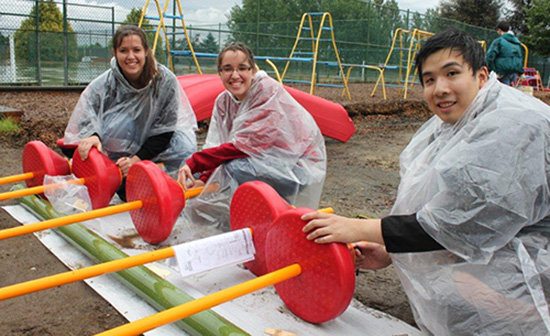 We’re proud to say that last week we worked together with Circle K International (CKI) members, Kiwanis and our local playground consultant, Habitat Systems, to build playgrounds at two deserving schools in Vancouver, British Columbia. More than 150 CKI volunteers installed playgrounds at Sir Wilfrid Laurier Elementary School and Sir Wilfrid Laurier Annex as part of CKI’s 13th Annual Large Scale Service Project, which took place prior to their annual convention.
We’re proud to say that last week we worked together with Circle K International (CKI) members, Kiwanis and our local playground consultant, Habitat Systems, to build playgrounds at two deserving schools in Vancouver, British Columbia. More than 150 CKI volunteers installed playgrounds at Sir Wilfrid Laurier Elementary School and Sir Wilfrid Laurier Annex as part of CKI’s 13th Annual Large Scale Service Project, which took place prior to their annual convention.
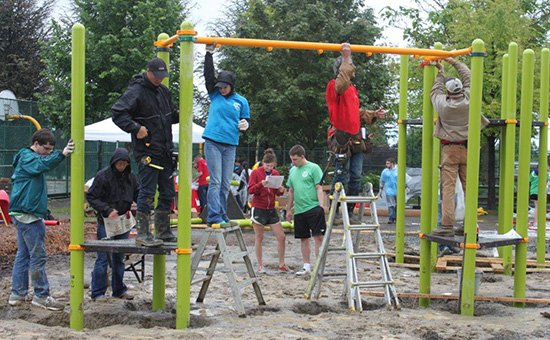
Both schools had aging wooden play structures that were scheduled for removal due to safety concerns. “The students were aware that the playgrounds were being removed, and were disappointed,” explained Janet Souther, principal of Sir Wilfrid Laurier Elementary School. “The Laurier parents, staff and students at both the Elementary and the Annex have been working hard on various fundraising projects but new playgrounds were still years away. Landscape Structures, Kiwanis, Habitat Systems and our local corporate donors have made these school playgrounds a reality and we are beyond grateful!”
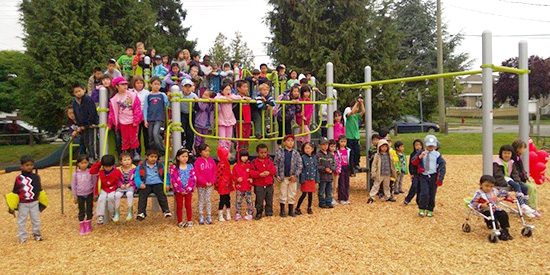
After two days of construction, some of which took place during rain showers, the two playgrounds were complete. On Thursday, June 27, both the Elementary and Annex celebrated the new playgrounds, in addition to the last day of school, with grand opening ceremonies.


